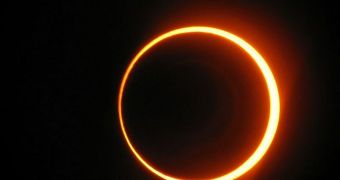In a paper published in the September 14 issue of the esteemed journal Geophysical Research Letters, investigators at the National Central University in Taiwan explained how the shadow the Moon casts on Earth produces atmospheric waves that travel at high speeds above the planet.
The NCU investigators determined that these waves can move at speeds exceeding 200 miles (321 kilometers) per hour. The results are in accordance with a theory proposing the existence of such an effect, which was first formulated back in the 1970s.
Due to a variety of reasons, primarily technical in nature, researchers were not able to conduct the necessary measurements to confirm or invalidate the proposal until a total solar eclipse covered the surface of the Sun on July 22, 2009, Space reports.
Surely enough, the team discovered that the trailing and leading edges of the Moon's shadow produced a large amount of acoustic (sound) waves, as it moved across the planet's surface. These formations are similar to the waves a ship produces as it moves through water, the NCU investigators say.
Under the directions of expert J. Y. Liu, the Taiwanese researchers were able to use a large network of GPS receivers placed at ground level. As the Moon's shadow passed over Taiwan and Japan during the 2009 eclipse, the devices were used to record disturbances in the atmosphere.
According to the results of the new study, the acoustic waves formed high above the surface, in Earth's ionosphere. This layer of the atmosphere contains parts of the mesosphere, thermosphere and exosphere, and is called thusly because it is heavily ionized by solar radiations.
“We not only find the feature of the predicted bow wave but also the stern wave on the equator side of the eclipse path, as well as the stern wake right behind the Moon’s shadow boat,” the team explains.
Experts also learned that the waves produced by the leading and trailing edges of the shadow were separated by a 30-minute interval, indicating that – in the maritime analogy – the Moon would be a ship about 1,712 kilometers (1,064 miles) long.
The primary reason for why the waves form in the first place is that the lunar shadow causes a significant temperature difference in the planet's atmosphere during the brief period of the eclipse.
The areas of the atmosphere that are still illuminated are significantly warmer than the obscured areas, and these differences are the sources of the acoustic waves.
At this point, researchers plan to continue their investigations this year, when another solar eclipse is bound to occur on November 25. However, the event will only be noticeable from Antarctica, Tasmania, New Zealand and southern South Africa.

 14 DAY TRIAL //
14 DAY TRIAL //